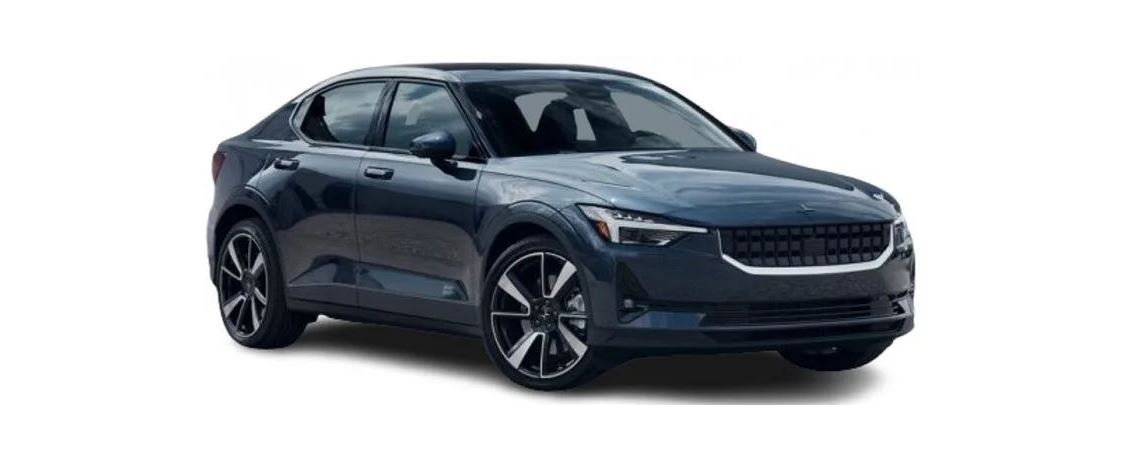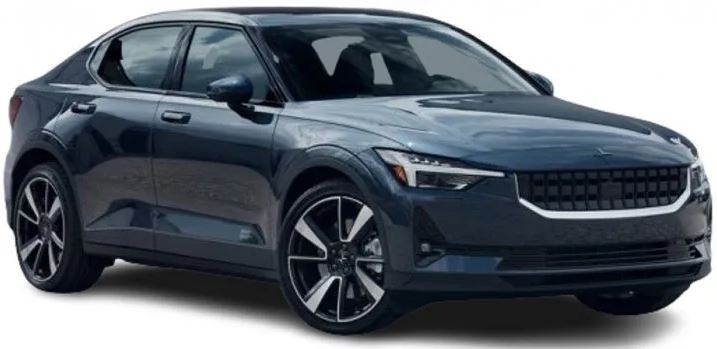2023 Polestar 2 Adaptive Cruise Control
Adaptive Cruise Control and Pilot Assist* displays(Depending on the market, these functions can be either standard or optional)
Symbol indication
 |
Both of the functions are selected but not active. |
 |
Adaptive Cruise Control is active.
Pilot Assist is selected but not available. The conditions for the function are not met. |
 |
Both of the functions are active. |
Speed
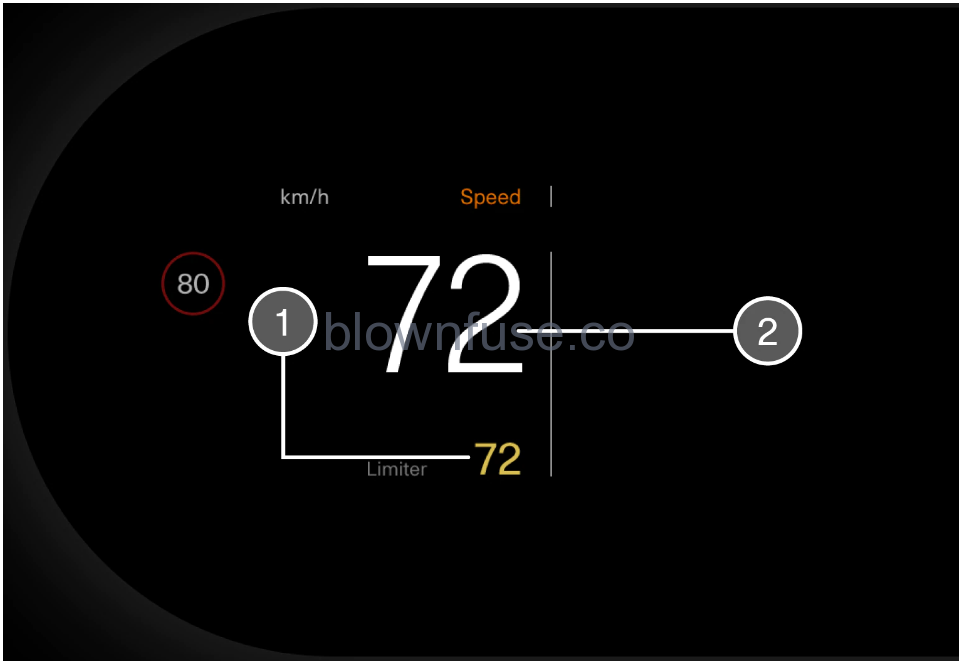
- Speed indicators.
- Set speed
Time interval
 |
When the symbol in the instrument panel shows a vehicle, the time interval to the vehicle ahead is being regulated. |
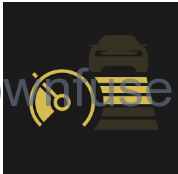 |
When no vehicle is shown, the functions are following the set speed. |
Adaptive Cruise Control*(Depending on market, this function can be either standard or optional)
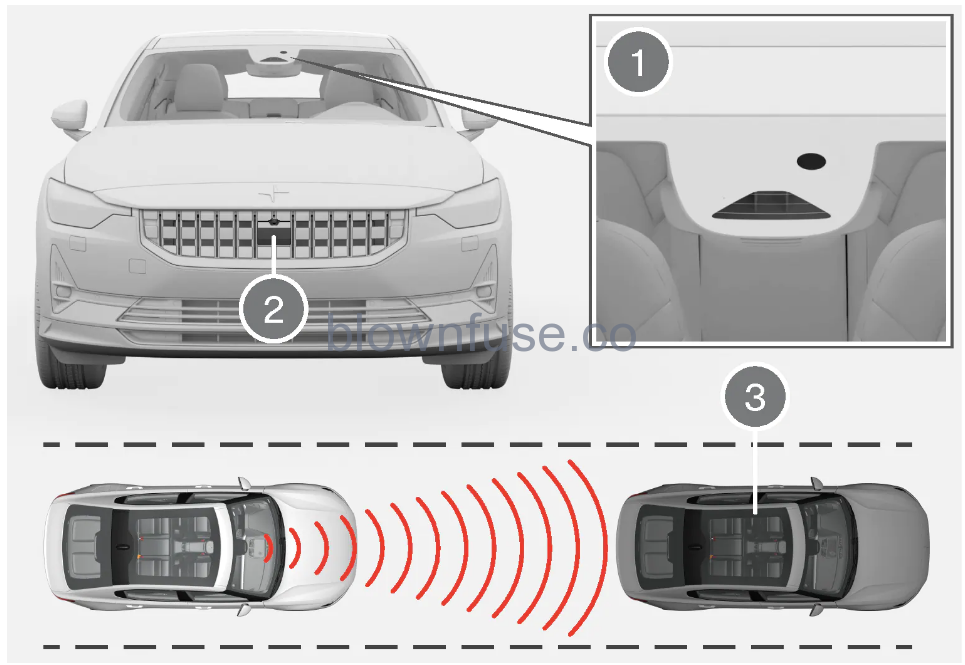
- The camera/radar sensor measures the distance to the vehicle ahead.
- Camera
- Radar sensor
Adaptive Cruise Control can help provide a more relaxed driving experience on long trips on highways or long, straight roads with even traffic flows.
The driver sets a speed and a time interval to the vehicle ahead. If the camera and radar units detect a slower vehicle in front of your own vehicle, your vehicle’s speed and the preset time interval will be automatically adapted to the vehicle ahead. When there are no longer slower-moving vehicles ahead, the vehicle will return to the set speed.
Adaptive Cruise Control regulates speed by accelerating and braking. It is normal for the brakes to emit a slight sound when they are being used to adjust speed.
Adaptive Cruise Control attempts to:
- smoothly regulate speed. The driver must apply the brakes in situations requiring immediate braking. For example, when there are great differences in speed between vehicles or if the vehicle ahead brakes suddenly. Due to limitations in the radar sensor, braking may occur unexpectedly or not at all.
- follow a vehicle ahead in the same lane and maintain a time interval to that vehicle set by the driver. If the radar sensor does not detect a vehicle ahead, it will instead maintain the speed set by the driver. This will also happen if the speed of the vehicle ahead exceeds the set speed for your vehicle.
Steep roads and/or heavy loads
Adaptive Cruise Control is primarily intended to be driven on flat roads. The function may not be able to maintain the correct time interval to the vehicle ahead when driving on steep downgrades. The driver should be extra attentive and prepared to apply the brakes.
Do not use Adaptive Cruise Control if the vehicle is carrying a heavy load or towing a trailer.
- This is not a collision-avoidance system. The driver is always responsible and must intervene if the system fails to detect a vehicle ahead.
- The function does not brake for people or animals and does not brake for small vehicles, such as bikes and motorcycles. Similarly, it does not brake for low trailers, oncoming, slow-moving or stationary vehicles and objects.
- Do not use the function in demanding situations, such as in city traffic, at intersections, on slippery surfaces, with a lot of water or slush on the road, in heavy rain/snow, in poor visibility, on winding roads, or on on/off ramps.
- The function is supplementary driver support intended to facilitate driving and help make it safer – it cannot handle all situations in all traffic, weather and road conditions.
- The driver is advised to read all sections in the Manual about this function to learn of its limitations, which the driver must be aware of before using the function.
- Driver support functions are not a substitute for the driver’s attention and judgment. The driver is always responsible for ensuring the vehicle is driven in a safe manner, at the appropriate speed, with an appropriate distance to other vehicles, and in accordance with current traffic rules and regulations.
The function uses the vehicle’s camera and/or radar units, which have certain general limitations.
Only a workshop may perform maintenance on driver support components – contact Polestar Customer Support.
Adaptive Cruise Control*(Depending on market, this function can be either standard or optional) standby mode
Standby mode means that the function is selected in the center display but not activated. The symbol in the instrument panel is extinguished and Adaptive Cruise Control is not regulating speed or distance to the vehicle ahead.
Standby mode due to action by the driver
Adaptive Cruise Control will be deactivated and put in standby mode if any of the following occurs:
- The brakes are applied.
- The gear selector is moved to N.
- The vehicle is driven faster than the set speed for more than 1 minute.
Temporarily increasing speed using the accelerator pedal, e.g. when passing another vehicle, will not affect the setting. The vehicle will return to the set speed when the accelerator pedal is released.
If Adaptive Cruise Control is in standby mode, the driver must intervene and regulate both speed and distance to the vehicle ahead.
Automatic standby mode
With automatic standby mode, the driver is warned by an acoustic signal and a message in the instrument panel.
- The driver must then regulate vehicle speed, apply the brakes if necessary, and maintain a safe distance to other vehicles.
Adaptive Cruise Control may go into standby mode if:
- Any of the systems that Adaptive Cruise Control is dependent on stops working, e.g. stability control/anti-skid (ESC).(Electronic Stability Control)
- The driver opens the door.
- The driver unbuckles the seat belt.
- The electric motor speed is too low/high.
- One or more of the wheels lose traction.
- The brake temperature is high.
- The parking brake is applied.
- The camera and/or radar sensors are covered by snow or heavy rain (the camera lens/radar waves are blocked).
- Your vehicle’s speed goes under 5 km/h (3 mph) and ACC cannot determine if the object ahead is a stationary vehicle or if it is another object, e.g. a speed bump.
- Your vehicle’s speed goes under 5 km/h (3 mph) and the vehicle ahead turns so that ACC no longer has a vehicle to follow.
Auto-hold braking with speed-controlling functions
Braking function in slow traffic and at a standstill
In slow-moving, stop-and-go traffic or when stopped at a traffic light, driving will resume automatically if the vehicle is stopped for less than approx. 3 seconds. If it takes more than 3 seconds for the vehicle ahead to begin moving again, the driver support function will go into standby mode and the auto-hold brake function will activate.
-
The function can be reactivated by:
- Pressing the
 button on the steering wheel keypad.
button on the steering wheel keypad. - Pressing the accelerator pedal.
- Pressing the
> The function will resume following the vehicle ahead if it begins to move within approx. 6 seconds.
A noticeable increase in speed may follow when the speed is resumed with the ![]() steering wheel button.
steering wheel button.
The driver support system only issues a warning for obstacles detected by its camera and radar units, which means that warnings may come after a delay or not at all.
- Never wait for a warning or assistance. Apply the brakes when necessary.
Driver support can keep the vehicle stationary for no more than 5 minutes – after that time the parking brake is applied and the function is deactivated.
The parking brake must be released before driver support can be reactivated.
Deactivation of the Auto-hold brake function
In certain situations, auto-hold will be deactivated when the vehicle is at a standstill and the function will go into standby mode. This means that the brakes will be released and the vehicle could begin to roll. The driver must actively apply the brakes to keep the vehicle stationary.
This can occur if:
- The driver depresses the brake pedal.
- The parking brake is applied.
- The gear selector is moved to the N or R position.
- The driver puts Adaptive Cruise Control or Pilot Assist in standby mode.
Auto Activate Parking Brake
The parking brake is applied if the function is keeping the vehicle stationary using the brakes and:
- The driver opens the door or unbuckles his/her seat belt.
- The function has kept the vehicle at a standstill for more than approx. 5 minutes.
- The brakes overheat.
Collision risk warning from speed-controlling functions
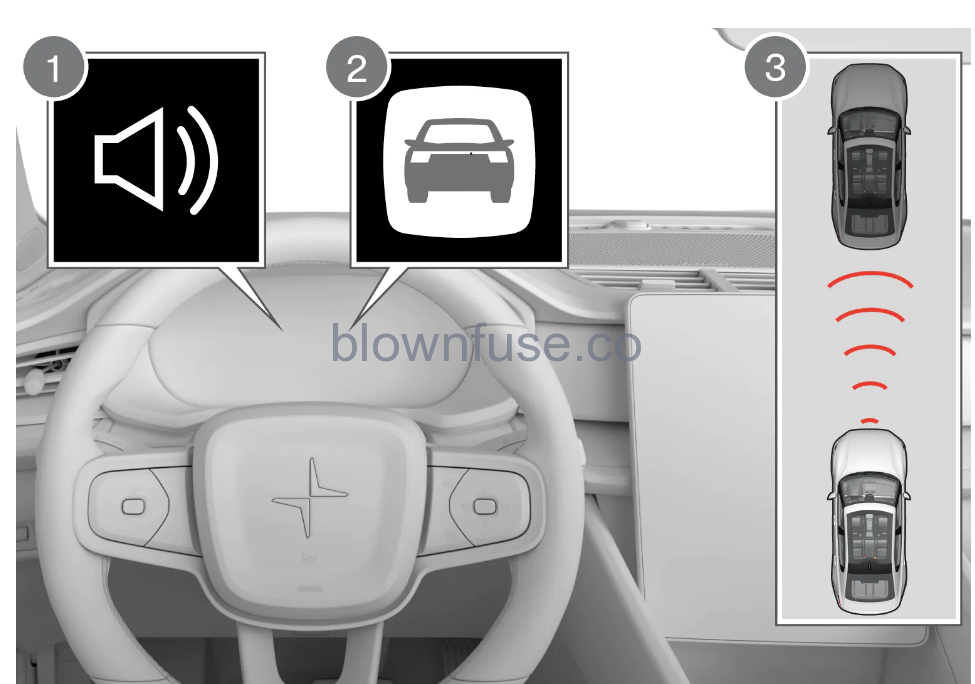
- Collision warning audible signal and symbol
- Collision warning audible signal
- Collision warning symbol
Adaptive Cruise Control and Pilot Assist use approx. 40% of the braking capacity. If a situation requires more braking force than driver support can provide, and if the driver does not apply the brakes, a warning light and audible warning signal will be activated to alert the driver that immediate action is required.
The driver support system only issues a warning for vehicles detected by its radar unit – thus, a warning may come after a delay or not at all. Never wait for a warning. Apply the brakes when necessary.
Setting stored speed for speed-controlling functions
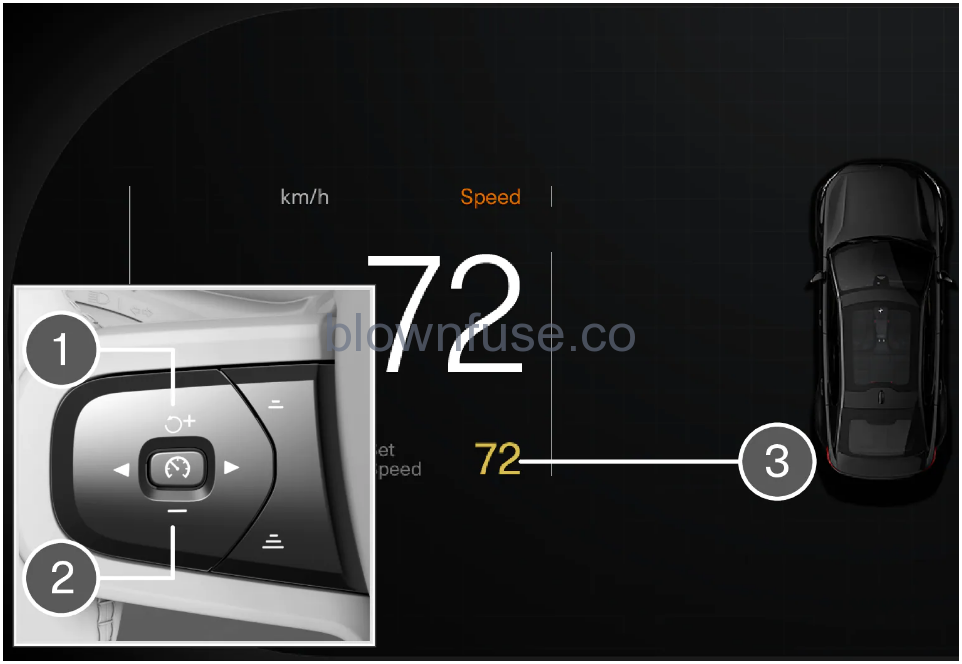
| Set speed |
-
Change a set speed by pressing the
 (1) or
(1) or  (2) buttons briefly or by pressing and holding them:
(2) buttons briefly or by pressing and holding them:- Brief press: Each press changes the speed in +/- 5 km/h (+/- 5 mph) increments.
- Press and hold: Release the button when the set speed indicator (3) has moved to the desired speed.
> The most recently set speed will be stored.
For vehicles without Adaptive Cruise Control*, speed instead increases by +/- 1 km/h (+/- 1 mph) each time the button is pressed.
Using the accelerator pedal
If speed is increased by depressing the accelerator pedal while pressing the (1) button ![]() on the steering wheel, the vehicle’s speed when the button is pressed will be stored as the set speed.
on the steering wheel, the vehicle’s speed when the button is pressed will be stored as the set speed.
Temporarily increasing speed using the accelerator pedal, e.g. when passing another vehicle, will not affect the setting. The vehicle will return to the set speed when the accelerator pedal is released.
Possible speed
The lowest speed that can be set is 30 km/h (20 mph). When following another vehicle, ACC can monitor that vehicle’s speed and slow your own vehicle down to a standstill, but it is not possible to set speeds lower than 30 km/h (20 mph).
The driver support functions can follow another vehicle at speeds from a standstill up to 200 km/h (125 mph).
Pilot Assist can provide steering assistance from near-stationary speeds up to 140 km/h (87 mph).
Setting time intervals to the vehicle ahead
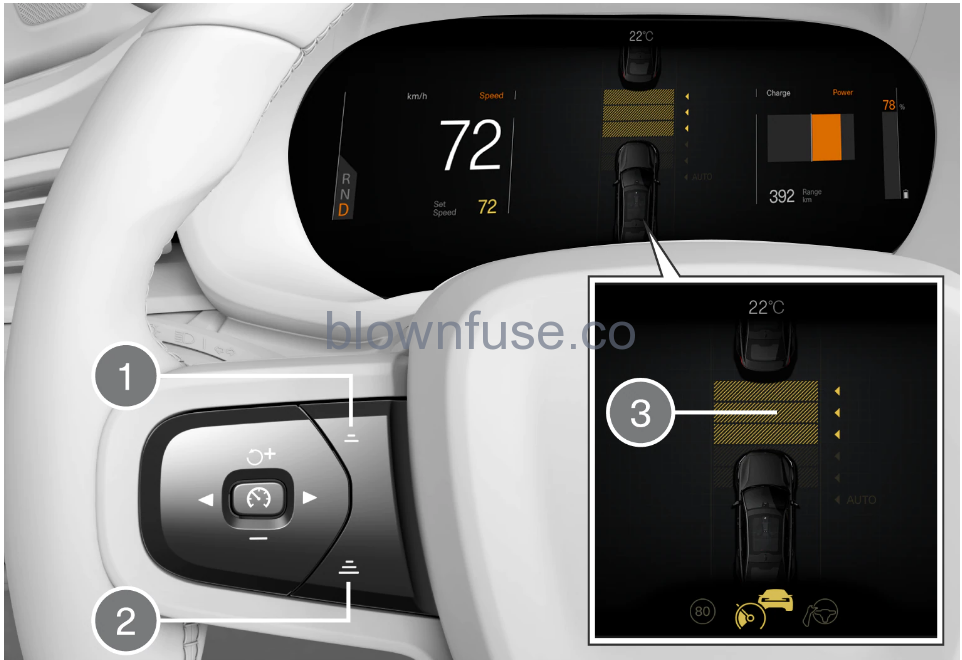
- Controls for setting a time interval.
- Reduce the time interval
- Increase the time interval
- Press the (1) or (2) button to decrease or increase the time interval.
> The distance indicator (3) shows the current time interval.
Different time intervals to the vehicle ahead can be selected and are shown in the instrument panel as 1–5 horizontal bars. The more bars, the longer the time interval. One bar represents an interval of approx. 1 second to the vehicle ahead. 5 bars represent approx. 3 seconds.
In order to help your vehicle follow the vehicle ahead as smoothly and comfortably as possible, Adaptive Cruise Control allows the time interval to vary noticeably in certain situations. At low speeds, when the distance to the vehicle ahead is short, Adaptive Cruise Control increases the time interval slightly.
When the symbol in the instrument panel shows a vehicle and a steering wheel, Pilot Assist is following a vehicle ahead at a preset time interval.
When only a steering wheel is shown, there is no vehicle ahead within a reasonable distance.
When the symbol in the instrument panel shows two vehicles, the Adaptive Cruise Control is following the vehicle ahead at a preset time interval.
When only one vehicle is shown, there is no vehicle ahead within a reasonable distance.
- The greater the vehicles’ speed, the greater the distance between them for a set time interval.
- Only use the time intervals permitted by local traffic regulations.
- If driver support does not seem to respond with a speed increase when activated, it may be because the time interval to the vehicle ahead is shorter than the set time interval.
- Only use a time interval suitable for the current traffic conditions.
- The driver should be aware that short time intervals give them limited time to react and act to any unforeseen traffic situation.
Switching target vehicles with speed-controlling functions
Switching target vehicles
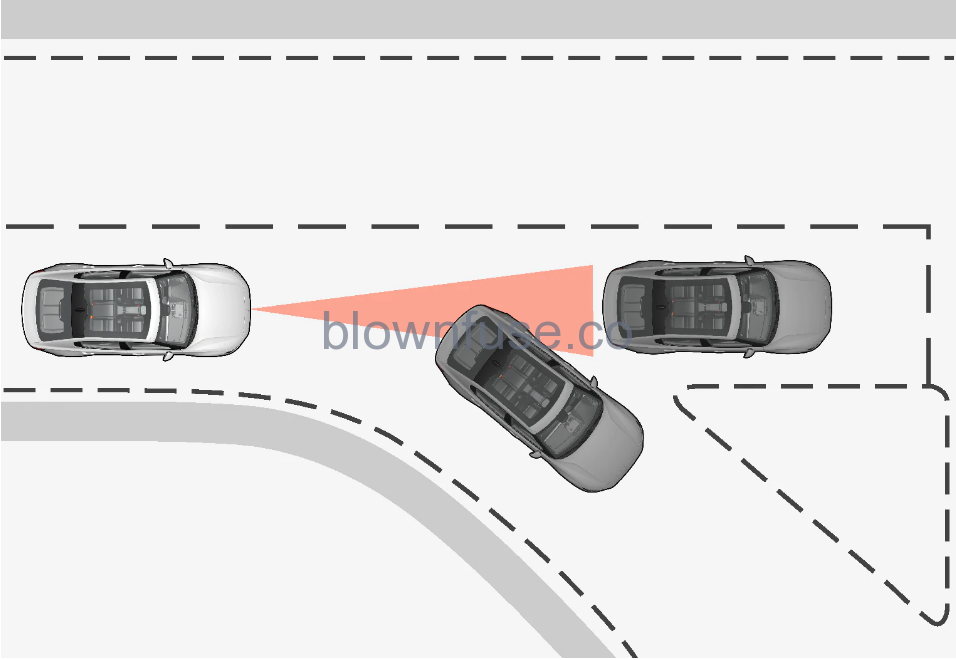
If the target vehicle ahead turns suddenly, there may be stationary traffic ahead.
When driver support is actively following another vehicle at speeds under 30 km/h (20 mph) and switches targets from a moving vehicle to a stationary vehicle, driver support will brake for the stationary vehicle.
When driver support follows another vehicle at speeds over approx. 30 km/h (20 mph) and changes target vehicle – from a moving vehicle to a stationary one – driver support will ignore the stationary vehicle and instead accelerate to the stored speed.
- The driver must then intervene and apply the brakes.
Automatic standby mode when switching targets
Driver support disengages and goes into standby mode if:
- your vehicle’s speed goes under 5 km/h (3 mph) and driver support cannot determine if the target is a stationary vehicle or if it is another object, e.g. a speed bump.
- your vehicle’s speed goes under 5 km/h (3 mph) and the vehicle ahead turns so that driver support no longer has a vehicle to follow.
Symbols and messages for Adaptive Cruise Control*
| Symbol | Message | Meaning |
|---|---|---|
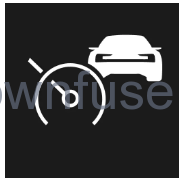 |
The symbol is illuminated | The vehicle is maintaining the set speed. |
 |
Adaptive Cruise Control Service required
The symbol is extinguished |
The system is not functioning as intended. Contact Polestar Customer Support.
Adaptive Cruise Control is in standby mode. |
 |
Radar sensor front Sensor blocked See Manual | Clean the surface of the grille in front of the radar sensor. |
A text message can be erased by briefly pressing the  button in the center of the right-side steering wheel keypad.
button in the center of the right-side steering wheel keypad.
If a message cannot be erased, contact Polestar Customer Support.
